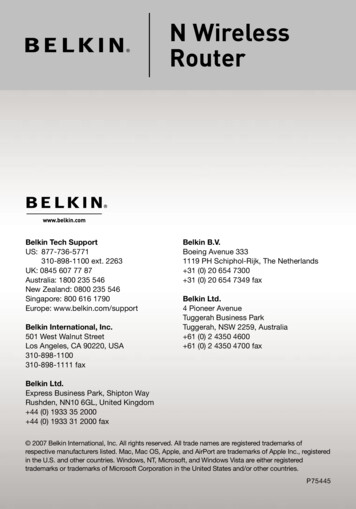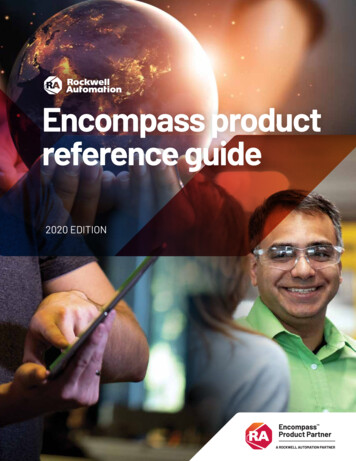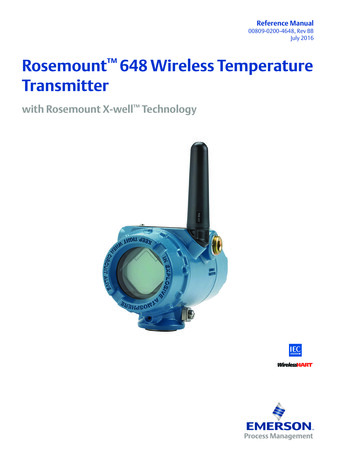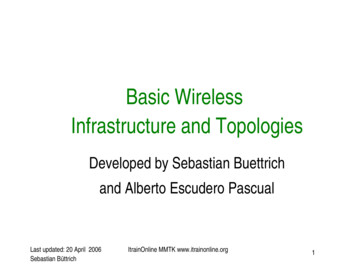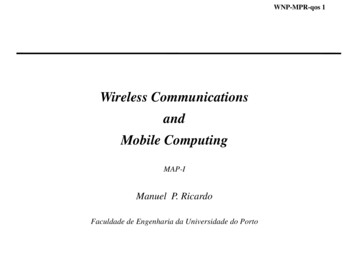
Transcription
WNP-MPR-qos 1Wireless CommunicationsandMobile ComputingMAP-IManuel P. RicardoFaculdade de Engenharia da Universidade do Porto
WNP-MPR-qos 2 In this lecture we will recall the QoS basics concepts and thenfocus in the QoS in wireless networks, namely 3GPP-QoS andIEEE-wireless-QoS
WNP-MPR-qos 3Quality of Service From a user’s point of view» level of satisfaction experienced by the user of an application whosetraffic is delivered through a network. Depends on– User’s subjective evaluation and expectations– Terminal capabilities– Performance of networks From a network point of view» ability of providing differentiated treatment totraffic flows or traffic classes» provide them with different levels of delivery guarantees– bandwidth, delay, loss» network behaviour characterizable by a set of performance parameters
WNP-MPR-qos 4QoS principles The provisioning of QoS requires» cooperation of various communications layers» cooperation of network elements in the end-to-end chain QoS requirements of users/applicationsmust be mapped into values of network service attributes Attributes of a network service» may be described by a set of performance (QoS) parameters» which must be observable, measurable and controllable Networks and users must negotiate contracts,which are described by means of offered traffic and QoS parameters
WNP-MPR-qos 5QoSQoS is an end-to-end problem, handled at several communication layersApplicationApplication control (e.g. SIP)Application nodeApplication nodeApplicationApp. node-backbonecontrol plane interfaceapp. controlInter-domain interfaceIP layerApplicationapp. controlTransportIP layerIP control planeIP control planeNetworkIPIPIP BackboneData linkApp. node-backboneuser plane (IP) interfacePhysicalSecurityIPQuality of ServiceIPIP user planeMobilityIP user planeControlMulticastControl
WNP-MPR-qos 6QoS building blocks in a packet networknetwork Data plane (traffic flows/packets)– Shaping, Policing– Classification & Marking– Queuing and Scheduling(service discipline)– Congestion control and Queuemanagement Control plane––––QoS mappingAdmission controlQoS routingResource reservation/allocation Management plane– Resource provisioning– Policy managementTraffic source/previous network elementfeed-back based,end-to-end (TCO, RTP RTCP)inter-network elementpacket switch(router, switch)
WNP-MPR-qos 7IP QoS Models 2 service models» IntServ - oriented towards the support of QoS per flow» DiffServ - oriented towards the provisioning of QoS to traffic classes Integrated Services (IntServ) model» Resource ReSerVation Protocol(RSVP)» TSpec, FlowSpec» Controlled load» Guaranteed service (maximum delay) Differentiated Services(DiffServ) model»»»»»DS fieldPer-Hop Behaviours (PHB)Assured Forwarding (AF)Expedited Forwarding (EF)Bandwidth broker
WNP-MPR-qos 8IntServ - RSVPResourceReSerVation Protocol (RSVP)
WNP-MPR-qos 9IntServ – Tspec, FlowSpec The FlowSpec - information that characterizes» the traffic to submit to the network (TSpec)» the service requested from the network (RSpec) TSpec includes the following parameters»»»»» p – peak rater – token bucket rateb – bucket sizeM – maximum datagram sizem – minimum policed unitRSpec is specified only for the Guaranteed service and includes» R – service rate (must be r)» S – delay slack (acceptable delay in addition to the delay obtained with R
WNP-MPR-qos 10IntServ – QoS Services Guaranteed Service» hard guarantees provided to real-time applications– Guaranteed bandwidth– Bound on end-to-end delay– No losses of conforming packets on the routers» Resources reserved per flow, based on a Flowspec (TSpec and RSpec) Controlled-Load Service» emulates the service provided by a moderately loaded best-effort network» only qualitative guarantees– Very high percentage of transmitted packets are successfully delivered– Delay of the majority of the packetswill not greatly exceed the minimum delay of a packet» The sender does not specify RSpec
WNP-MPR-qos 11DiffServ – DSCP field01234567 --- --- --- --- --- --- --- --- DSCP CU --- --- --- --- --- --- --- --- DSCP: differentiated services codepointCU: currently unused
WNP-MPR-qos 12Diff Serv – PHB, AF, EF Per-Hop Behaviours (PHB)» Packets marked with the same DSCP, receive similar treatment 3 PHBs defined» Best effort» Assured Forwarding (AF)– Service provides qualitative guarantees, based on priorities– Service characterized by a high probability of packet delivery– may be used to implement the Olympic service (gold, silver and bronze classes)» Expedited Forwarding (EF)– aimed at building services characterized bylow packet loss ratio, low latency and low jitter
WNP-MPR-qos 13DiffServ - Bandwidth broker
WNP-MPR-qos 14QoS in UMTS
WNP-MPR-qos 15Quality of Service in UMTSUMTSTEMTRANCNGatewayCNEDGENODETEEnd-to-End ServiceTE/MT LocalBearer ServiceExternal BearerServiceUMTS Bearer ServiceRadio Access Bearer ServiceRadio BearerServicePhysical RadioBearer ServiceRAN AccessBearer ServicePhysicalBearer ServiceCN BearerServiceBackboneBearer Service
WNP-MPR-qos 16QoS management functions,UMTS bearer service, user planeTEMTRANCN .Local BSResourceMana gerResourceMana gerRAN phys. BSdata f low with indication ofMapp erResourceMana gerMapp erResourceMana gerRAN Access netw ork servicedirectionMapp erResourceMana gerResourceMana gerBB netw ork servic eExternal BS
TEMTWNP-MPR-qos17GatewayRANCN EDGEExt.Netw.Classif.Classif.Cond.Cond.Cond.Local BS ClassResourceMana gerResourceMana gerRAN phys. BSdata f low with indication ofMapp erResourceMana gerMapp erResourceMana gerRAN Access netw ork serviceMapp erResourceMana gerResourceMana gerBB netw ork servic edirection» Classifies and marks packet» At the entry of network (downlink GGSN, uplink terminal) Cond – Traffic conditioner» Enforces compliance of flow with QoS attributes» At the entry of the network and radio segment Mapper» marks packet with QoS information related to bearer service below Resource manager» Decides when to send the packet so that QoS is satisfied» Manages the resources it sees– Packet queues, ARQ mechanisms, modulations and codes, power, spreading codesExternal BS
WNP-MPR-qos 18UMTS QoS ClassesTraffic classConversational classStreaming classFundamentalcharacteristicsPreserve time relation(variation) betweeninformation entities ofthe streamPreserve timerelation (variation)betweeninformation entitiesof the streamInteractive classRequest-responsepatternPreserve payloadcontentConversational pattern(stringent and lowdelay)Example of theapplicationvoiceBackgroundDestination isnot expectingthe data within acertain timePreservepayload contentstreaming videoWeb browsingBackgrounddownload ofemails
WNP-MPR-qos 19UMTS Bearer Service Attributes – Examples Traffic class ('conversational', 'streaming', 'interactive', 'background')Maximum bitrate (kbit/s)»» Guaranteed bitrate (kbit/s)»»» fraction of SDUs lost or detected as erroneousResidual bit error ratio» traffic compliance enforced bytoken-bucket (Guaranteed-bitrate , Maximum-SDU-size)Delay/ reliability attributes guaranteed only for traffic up to the Guaranteed bitrateUsed for admission control and resource allocationMaximum SDU size (octets)SDU error ratio» compliance enforced bytoken-bucket (Maximum-bitrate , Maximum-SDU-size)used to reserve codes in WCDMA radio interface - downlinkUndetected bit error ratio in the delivered SDUsTransfer delay (ms)»95th percentile of the delay distribution
WNP-MPR-qos 20Token BucketOKOKNon-compliantTBCL1 TBCL2 TBCL3 TBCbb-L1 r* Tb-L1TimeToken Bucket Counter (TBC) - number of remaining tokens at any time
WNP-MPR-qos 21QoS attributes versus traffic classesConversationalclassStreaming classInteractive classBackground classMaximum bit rateXXXXDelivery orderXXXXMaximum SDU sizeXXXXSDU formatinformationXXSDU error ratioXXXXResidual bit errorratioXXXXDelivery oferroneous SDUsXXXXTransfer delayXXGuaranteed bit rateXXTraffic classTraffic handlingpriorityXAllocation/Retention priorityXXSource statisticsdescriptorXXSignalling IndicationXXX
WNP-MPR-qos 22UMTS Bearer Service Attributes (Rel. 7!)Traffic classConversationalclassStreaming classInteractive classBackgroundclass 256 000 (2) 256 000 (2) 256 000 (2) 256 000 (2)Yes/NoYes/NoYes/NoYes/No 1 500 or 1 502(4) 1 500 or 1 502(4) 1 500 or 1 502(4) 1 500 or 1 502(4)(5)(5)Yes/No/- (6)Yes/No/- (6)Yes/No/- (6)Yes/No/- (6)Residual BER5*10-2, 10-2, 5*103, 10-3, 10-4, 10-5,10-65*10-2, 10-2, 5*103, 10-3, 10-4, 10-5,10-64*10-3, 10-5, 6*108 (7)4*10-3, 10-5, 6*108 (7)SDU error ratio10-2, 7*10-3, 10-3,10-4, 10-510-1, 10-2, 7*10-3,10-3, 10-4, 10-510-3, 10-4, 10-610-3, 10-4, 10-6Transfer delay (ms)100 – maximumvalue300 (8) –maximum value 256 000 (2) 256 000 (2)Maximum bitrate (kbps)Delivery orderMaximum SDU size (octets)SDU format informationDelivery of erroneous SDUsGuaranteed bit rate (kbps)Traffic handling priorityAllocation/Retention prioritySource statistic descriptorSignalling Indication1,2,3 No (9)1,2,3
WNP-MPR-qos 23PDP Context Activation Procedure for Iu modeMSRANSGSNGGSN1. Activate PDP Context RequestC14. Create PDP Context Request4. Create PDP Context Response5. Radio Access Bearer Setup6. Invoke Trace8. Update PDP Context Request8. Update PDP Context ResponseC29. Activate PDP Context Accept
WNP-MPR-qos 24Network-RequestedPDP Context Activation ProcedureMSSGSNHLRGGSN1. PDP PDU2. Send Routeing Info for GPRS2. Send Routeing Info for GPRS Ack3. PDU Notification Request3. PDU Notification Response4. Request PDP Context Activation5. PDP Context Activation procedure
WNP-MPR-qos 25Protocol architecture of NAS supporting PSmode, Terminal Equipment side
WNP-MPR-qos 26Primitives and Parameters atSMREG-SAP - MS side
WNP-MPR-qos 27UMTS QoS Conceptual ModelsUELocalUEGGSNRemoteAPRemoteHostRemoteHostIP Bearer ServiceGGSNSGSNGn/GpScope of PDP ContextBackbone IPNetworkRemoteAccessPointIP BearerLayerAccessBearerLayer(eg. UMTSBearer)
WNP-MPR-qos 28Local UE does not support IP QoSThe UE controlsthe QoS mechanismsfrom the UE.QoS in UMTS controlled byPDP context.QoS in backbone network controlled QoS on remote accesslink controlled byby DS. DS marking performed byGGSN.DS.Application Layer (eg. SIP/SDP)Uplink DataDSPDP FlowThe UE may controlthe QoS mechanismsfrom receivedinformation.QoS in UMTS controlled byPDP context selected byTFT.QoS in backbone network controlled QoS on remote accessby DS. DS marking performed bylink controlled byRUE, or remarking by RAP.DS or other means.Application Layer (eg. SIP/SDP)DSDownlink DataPDP FlowUEGGSNRemoteAPRemoteHost
WNP-MPR-qos 29Local UE supports DiffServ (DS)The UE controlsthe QoS mechanismsfrom the UE.QoS in UMTS controlled byQoS in backbone network controlled QoS on remote accessPDP context.link controlled byby DS. DS marking performed byUE DS marking carriedDS.UE (or remarking by GGSN).transparently.Application Layer (eg. SIP/SDP)DSUplink DataPDP FlowThe UE may controlthe QoS mechanismsfrom receivedinformation.QoS in UMTS controlled byQoS in backbone network controlled QoS on remote accessPDP context selected byby DS. DS marking performed bylink controlled byTFT.RUE, or remarking by RAP.DS or other means.Remote DS marking/GGSNremarking carriedtransparently.Application Layer (eg. SIP/SDP)DSDownlink DataPDP FlowUEThe UE performsDS edge functions.GGSNRemoteAPRemoteHost
WNP-MPR-qos 30Local UE supports RSVP signalling and DiffServThe UE controlsthe QoS mechanismsfrom the UE.QoS in UMTS controlled byPDP context.UE DS marking and RSVPsignalling carriedtransparently.QoS in backbone network controlled QoS on remote accesslink controlled byby DS. DS marking performed byeither DS or RSVP.UE, or by GGSN based on PDPcontext signalling.RSVP signalling carriedtransparently.Application Layer (eg. SIP/SDP)RSVP SignallingDSUplink DataPDP FlowThe UE may controlthe QoS mechanismsfrom receivedinformation.QoS in UMTS controlled byQoS in backbone network controlled QoS on remote accessPDP context selected byby DS. DS marking performed bylink controlled byTFT.RUE (or remarking by RAP).either DS or RSVP.Remote DS marking/GGSNRSVP signalling carriedremarking and RSVPtransparently.signalling carriedtransparently.Application Layer (eg. SIP/SDP)RSVP SignallingDSDownlink DataPDP FlowUEThe UE performsDS edge functionsand RSVPGGSNRemoteAPRemoteHost
WNP-MPR-qos 31UMTS – Radio Resource Management UMTS – WCDMAWhat are the causes of high packet delays?» Low transmission information rate R high packet service time (transmission time) long queues high waiting time delay» Packet retransmissions caused by packet loss What are the causes of packet loss?» High BER What are the causes high BER?
WNP-MPR-qos 32Uplink Capacity –Maximum Number ( N ) of users– Ideal power control (every sinal received same power)– N users transmitting at same data bitrate R bit/sN – number of usersCC1 I C ( N 1) N 1Eb I0C – power received form each user (W)I – interference from other users (W)Eb – energy received per information bit (J/bit)CR W C W 1IR IR N 1WI0 – Interference spectral density (J/Hz)W –chip rate (chip/s)R – information bitrate (bit/s)N – Eb/Io decreases BER increases, or– Alternatively, for a given Eb/Io , BER,W 1R EbI0N N, R Ri 1i need to be managed admission control
WNP-MPR-qos 33Load Factor, Uplink(from Holma & Toskala, 3rd edition)
WNP-MPR-qos 34Load Factor, Uplink(from Holma & Toskala, 3rd edition)
WNP-MPR-qos 35Admission Control Based on Throughput
WNP-MPR-qos 36WLAN- QoS
WNP-MPR-qos 37DCF - Distributed Coordination Function Listen before-talk, CSMA/CA basedStation transmists when medium is free for time greater than DIFSRandom backoff used when medium is S2- Packet arrivalDATA- Transmission of DATADIFS- Time interval DIFS
WNP-MPR-qos 38PCF - Point Coordination Function Contention-free frame transferPoint Coordinator (PC/AP) pools stationsPIFS time used to enter Contention Free PeriodPIFS SIFSPCSIFSData PollBeaconContentionPeriodSIFSPIFSData PollDATA ACKSIFSSIFSCF-EndData PollSIFS(no response)Contention Free PeriodACKTimeCP
WNP-MPR-qos 39802.11e – QoS Support for WLAN Basic elements for QoS» Traffic Differentiation– 4 Access Categories, 8 Traffic Classes» Concept of Transmission Opportunity (TXOP)– Transmission of multiple frames New Contention-based channel access» Enhanced Distributed Channel Access (EDCA) New Contention-free channel access» HCF Controlled Channel Access (HCCA)
WNP-MPR-qos 40HCF- Hybrid Coordination FunctionSTASTASTASTASTASTAHCPCSTASTASTASTA( Enhanced Station )BSS (Basic Service Set)DCFPCFQBSS (Basic Service Set for QoS)EDCAHCCA
WNP-MPR-qos 41HCF - Hybrid Coordination Function During Contention Free Period» Polls STAs and gives a station the permission to access channel» Specifies time and maximum duration of each TXOP During Contention Period» Controlled Contention– STA may send traffic with different priorities– STAs may also request resources» HC can send polled TXOPs during CP
WNP-MPR-qos 42EDCA 4 Access Categories (AC)»»»» AC VO (Voice)AC VI (Video)AC BE (best-effort)AC BK (background)Contention between ACs (and STAs)An Inter-frame Space (IFS) for each ACArbitration Inter frame Space (AIFS) Contention-Window (CW) depends on AC Mapping Priorities into AC»»AC1AC2AC3IEEE 802.1D and IEEE 802.1QSee NSA slidesVirtual CollisionAC4
WNP-MPR-qos 43Access Category [AC3] FrameBackOff[AC2] FrameBackOff[AC1] FrameBackOff[AC0] Frame
WNP-MPR-qos 44MAC Parameters Prioritized Channel Accessimplemented using MAC parameters per ACAC VOice [0]AC VIdeo [1]AC BE [2]AC BK [3]AIFSN2237CWmin371515CWmax71510231023AIFS [AC] AIFSN [AC] * aSlotTime SIFSIf CW[AC] is less than CWmax[AC], CW[AC] shall be set to the value (CW[AC] 1)*2 – 1.
WNP-MPR-qos 45Transmission Opportunity (TXOP) TXOP: duration a STA has to transmit frame(s)When will a STA get a TXOP ?» Winning a contention in EDCA during Contention Period» Receiving a “polled TXOP” from HC
WNP-MPR-qos 46Transmission Opportunity (TXOP) (cont.) In TXOP, frames exchange sequences are separated by SIFS
WNP-MPR-qos 47HCF Controlled Channel Access (HCCA) Procedure similar to PCFHybrid Coordinator (HC)» Controls the iteration of CFP and CP– By using beacon, CF-End frame and NAV Mechanism (similar to PCF)» Use polling scheme to assign TXOP to STA– Issue CF-poll frame to poll STA– Polling can be issued in both CFP & CP
WNP-MPR-qos 48Resources Managed in WLAN Resources are the time slots» Used to transmit bits according to the modulations/codes used WLAN enables to send differentiated traffic» By giving priority to real type traffic WLAN enables a flow to get a bit rate /delay» By using polling What needs to be managed by the HC?» The time slots available» Who uses them and when
GGSN Remote AP Remote Host The UE controls the QoS mechanisms from the UE. The UE may control the QoS mechanisms from received information. The UE performs DS edge functions. QoS on remote access link controlled by DS. QoS on remote access link controlled by DS or other means. QoS in UMTS controlled by PDP context. UE DS marking carried .




